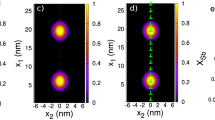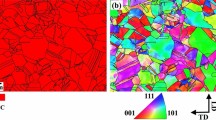Alloying element partition and growth kinetics of proeutectoid ferrite in deformed austenite were studied in an Fe-0.1C-3Mn-1.5Si alloy. Very small ferrite particles, less than several microns in size, were formed within the austenite matrix, presumably at twin boundaries as well as at austenite grain boundaries. Scanning transmission electron microscopy–energy-dispersive X-ray (STEM-EDX) analysis revealed that Mn was depleted and Si was enriched in the particles formed at temperatures higher than 943 K (670 °C). These were compared with the calculation of local equilibrium in quaternary alloys, in which the difference in diffusivity between two substitutional alloying elements was assumed to be small compared to the difference from the carbon diffusivity in austenite. Although the growth kinetics were considerably faster than calculated under volume diffusion control, a fine dispersion of ferrite particles was readily obtained in the partition regime due to sluggish growth engendered by diffusion of Mn and Si.













Similar content being viewed by others
Notes
It is assumed that the precipitate collects solute atoms from the matrix of a cylindrical shape, whose radius and length are proportional to \( \sqrt {D_{V} t} \) and \( \sqrt {D_{p} t} \), respectively, at an early stage of growth. The volume of the cylinder is equal to the volume of a hypothetical diffusion cell approximated as a sphere of radius\( \sqrt {D_{\text{app}} t} \), thus giving the preceding relationship.
References
H.I. Aaronson and H.A. Domian: Trans. TMS-AIME, 1966, vol. 236, pp. 781–96.
K.R. Kinsman and H.I. Aaronson: Metall. Trans., 1973, vol. 4, pp. 959–67.
J.R. Bradley and H.I. Aaronson: Metall. Trans. A, 1981, vol. 12A, pp. 1729–50.
K. Oi, C. Lux, and G.R. Purdy: Acta Mater., 2000, vol. 48, pp. 2147–55.
A. Phillion, H.S. Zurob, C.R. Hutchinson, H. Guo, D.V. Malakhov, J. Nakano, and G.R. Purdy: Metall. Mater. Trans. A, 2004, vol. 35A, pp. 1237–42.
C.R. Hutchinson, H.S. Zurob, and Y. Brechet: Metall. Mater. Trans. A, 2006, vol. 37A, pp. 1711–20.
T. Tanaka, H.I. Aaronson, and M. Enomoto: Metall. Trans. A, 1995, vol. 26A, pp. 547–59.
T. Tanaka, H.I. Aaronson, and M. Enomoto: Metall. Trans. A, 1995, vol. 26A, pp. 561–80.
H. Guo, G.R. Purdy, M. Enomoto, and H.I. Aaronson: Metall. Mater. Trans. A, 2006, vol. 37A, pp. 1721–29.
H. Yada, C.M. Li, and H. Yamagata: ISIJ Int., 2000, vol. 40, pp. 200–06.
M. Hillert: The Mechanism of Phase Transformations in Crystalline Solids, Institute of Metals, London, 1969, pp. 231–47.
M. Hillert: in Thermodynamics and Phase Transformations, J. Ågren, Y. Bréchet, C. Hutchinson, J. Philibert, and G. Purdy, eds., EDP Sciences, Cedex, France, 2006, pp. 9–24.
J.S. Kirkaldy: Can. J. Phys., 1958, vol. 36, pp. 907–16.
G.R. Purdy, D.H. Weichert, and J.S. Kirkaldy: Trans. TMS-AIME, 1964, vol. 230, pp. 1025–34.
D.E. Coates: Metall. Trans., 1972, vol. 3, pp. 1203–12.
D.E. Coates: Metall. Trans., 1973, vol. 4, pp. 1077–86.
M. Enomoto: Metall. Mater. Trans. A, 2006, vol. 37A, pp. 1703–10.
R.F. Sekerka and S.L. Wang: in Lectures on the Theory of Phase Transformations, 2nd ed., H.I. Aaronson, ed., TMS, Warrendale, PA, 1999, pp. 231–84.
T. Tanaka, H.I. Aaronson, and M. Enomoto: Metall. Mater. Trans. A, 1995, vol. 26A, pp. 535–44.
M. Enomoto and H.I. Aaronson: Metall. Trans. A, 1987, vol. 18A, pp. 1574–57.
M. Enomoto: Int. Conf. on Physical Metallurgy of Thermomechanical Processing of Steels and Other Metals, Tokyo, June 6–10, 1998, I. Tamura, ed., The Iron and Steel Institute of Japan, Tokyo, 1988, pp. 360–67.
J.R. Bradley, J.M. Rigsbee, and H.I. Aaronson: Metall. Trans. A, 1977, vol. 8A, pp. 323–33.
J. Fridberg, L.-E. Torndahl, and M. Hillert: Jernkontorets Ann., 1969, vol. 153, pp. 263–76.
H.B. Aaron and H.I. Aaronson: Acta Metall., 1968, vol. 16, pp. 789–98.
N.L. Peterson: Grain-Boundary Structure and Kinetics, ASM, Metals Park, OH, 1980, pp. 209–38.
J. Friedel: Dislocations, Pergamon, Oxford, United Kingdom, 1964, pp. 406–08.
P. Shewmon: Diffusion in Solids, 2nd ed., TMS, Warrendale, PA, 1989, pp. 112–15.
L.C. Brown and J.S. Kirkaldy: Trans. TMS-AIME, 1964, vol. 230, pp. 223–26.
Acknowledgment
We are thankful to Dr. T. Yamashita, Steel Research Laboratory, JFE Steel Corporation, for her assistance in the experiment.
Author information
Authors and Affiliations
Corresponding author
Additional information
Manuscript submitted July 27, 2010.
Appendix
Appendix
Equation of isoactivity surface of carbon in quaternary austenite
It is demonstrated that Eq. [2] represents the isoactivity surface of carbon that passes through the bulk alloy composition. To begin with, the logarithm of the activity of carbon in austenite is expanded to the first order about the austenite end of the interfacial tie-line (point b in Figure 6) as
Since this surface passes through the bulk alloy composition, i.e., a C(o) = a C(b), it is expressed by the equation
when points b and o are not far from each other.
On the other hand, substitution of Eqs. [5] through [7] into Eq. [2] yields
Since\( D_{22}^{\gamma } < < D_{11}^{\gamma } \) and \( D_{33}^{\gamma } < < D_{11}^{\gamma } \), Eq. [A3] is reduced to
When solute 1 ( = carbon) is interstitial and solutes 2 ( = Mn) and 3 ( = Si) are substitutional, Brown and Kirkaldy[28] have shown that
and
Rights and permissions
About this article
Cite this article
Wei, R., Kanno, K. & Enomoto, M. Alloying Element Partition and Growth Kinetics of Proeutectoid Ferrite in Hot-Deformed Fe-0.1C-3Mn-1.5Si Austenite. Metall Mater Trans A 42, 2189–2198 (2011). https://doi.org/10.1007/s11661-011-0646-7
Published:
Issue Date:
DOI: https://doi.org/10.1007/s11661-011-0646-7




